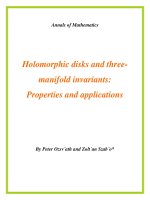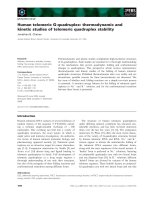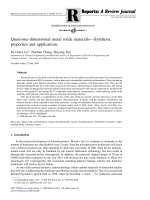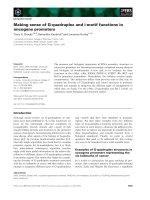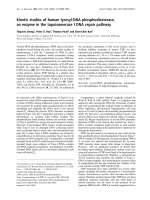Studies of new properties and applications of g quadruplex DNA
Bạn đang xem bản rút gọn của tài liệu. Xem và tải ngay bản đầy đủ của tài liệu tại đây (1.32 MB, 80 trang )
STUDIES OF NEW PROPERTIES
AND APPLICATIONS OF G-QUADRUPLEX DNA
NG TAO TAO MAGDELINE
B.Sc. (Hons.), NUS
A THESIS SUBMITTED
FOR THE DEGREE OF THE MASTER OF SCIENCE
DEPARTMENT OF CHEMISTRY
NATIONAL UNIVERSITY OF SINGAPORE
2010
ACKNOLEDGEMENTS
I would like to express my sincere appreciation to my supervisor, Associate Professor
Tan Choon Hong for his invaluable guidance and encouragement throughout my graduate
studies. Particularly, his ever optimistic outlook regardless of the various problems I
present him.
In addition, a special appreciation to Associate Professor Li Tianhu, for his invaluable
guidance, unwavering support, inspiration and encouragement throughout this course of
study. He performed the roles of an extraordinary professor, a caring mentor and a true
friend indeed. The wealth of knowledge I have attained thus far is a testimony of his
passion and ability to nurture students under his wing.
Working as a team with my fellow laboratory mates had been a joyful and fulfilling
experience. I would like to thank all that have shared this friendship and wonderful time
together.
I would also like to express my heartfelt gratitude to my family for their sacrificial love
and steadfast support throughout my education.
Last but not least, my utmost thanks to the National University of Singapore for the
research scholarship and more importantly, a memorable education experience.
i
TABLE OF CONTENTS
Acknowledgements
i
Table of Contents
ii
Summary
vii
List of Tables
viii
List of Figures
ix
List of Publications
xiii
Chapter 1
Introduction
1
1.1
Basic information of DNA
1
1.2
Basic information of G-quadruplex
2
1.2.1 Discovery of G-quadruplex
2
1.2.2 Various structural polymorphism of G-quadruplex 2
1.2.2.1 Strand stoichiometry variation
2
1.2.2.2 Strand polarity configurations
3
1.2.2.3 Connecting loops
4
1.2.3 Possible roles of G-quadruplex in-vivo
1.3
Chapter 2
References
Discovery of site specific self-cleavage of certain
5
7
9
artificially designed and non-biologically relevant
assemblies of G-quadruplex
ii
2.1
Introduction
9
2.2
Results and Discussion
11
2.2.1 Confirmation of the occurrence of the
11
self-cleavage reaction in a site specific feature
and hydrolytic pathway
2.2.2 Verification of G-quadruplex nature of our
18
deoxyribozymes for the self-cleaving activity
2.3
Effect of certain factors on the G-quadruplex based
21
self-cleavage reaction
2.3.1 Alkali metal ion dependence on the formation
21
of G-quadruplex structure
2.3.2 Effect of potassium ion concentrations on the
22
self-cleavage reaction
2.3.3 Effect of temperature dependence on the
25
self-cleavage reaction
Chapter 3
2.3.4 Effect of pH dependence on cleavage reactions
26
2.4
Proposed mechanism
27
2.5
Conclusion
28
2.6
References
29
Discovery of site specific self-cleavage of G-quadruplexes
31
formed by human telemetric repeats
3.1
Introduction
31
iii
3.2
Results and Discussion
33
3.2.1 Confirmation of the occurrence of the
33
self-cleavage reaction in a site specific feature
and hydrolytic pathway
3.2.2 Verification of G-quadruplex nature of our
35
deoxyribozymes for the self-cleaving activity
3.2.3 Effect of certain factors on the G-quadruplex
39
based self-cleavage reaction
3.2.3.1 Alkali metal ion concentration
39
dependence on the formation of
G-quadruplex structure
3.2.3.2 Effect of temperature dependence on
40
the self-cleavage reaction
3.2.3.3 Effect of magnesium ion and histidine
40
on the cleavage reaction
3.2.3.4 Effect of loop lengths
Chapter 4
42
3.2.4 Proposed mechanism
44
3.3
Conclusion
44
3.4
References
45
Discovery of site specific self-cleavage of G-quadruplexes
47
formed by yeast telemetric repeats
4.1
Introduction
47
iv
4.2
Results and Discussion
48
4.2.1 Confirmation of the occurrence of the
48
self-cleavage reaction in a site specific feature
and hydrolytic pathway
4.2.2 Verification of G-quadruplex nature of our
50
deoxyribozymes for the self-cleaving activity
4.2.3 Effect of certain factors on the G-quadruplex
53
based self-cleavage reaction
4.2.3.1 Alkali metal ion concentration
53
dependence on the formation of
G-quadruplex structure
4.2.3.2 Effect of temperature dependence on
54
the self-cleavage reaction
4.2.3.3 Effect of time dependence on the
55
self-cleavage reaction
Chapter 5
4.2.4 Proposed mechanism
56
4.3
Conclusion
57
4.4
References
57
Materials and methods
59
5.1
Materials
59
5.1.1
Oligodeoxyribonucleotides
59
5.1.2 Enzymes, chemicals and equipments
60
v
5.2
5.1.3 Buffers and solutions
60
Methods
60
5.2.1 Radioactive labeling DNA at the 5'-end with 32P
61
5.2.2 Polyacrylamide gel electrophoresis (PAGE)
61
5.2.3 NAP gel filtration
62
5.2.4 Autoradiography
63
5.2.5 Methylene blue staining
63
5.2.6 Self-cleavage assays of deoxyribozymes
64
5.2.7 pH dependency of the self-cleavage reaction
64
5.2.8 Alkali-ion dependency of the self-cleavage
65
reaction
5.2.9 Magnesium dependence of the self-cleavage
65
reaction
5.2.10 Hydrolysis of circular DNA with T7
65
exdonucleases
5.2.11 CD measurement
5.3
References
66
66
vi
SUMMARY
With the aim of exploring new properties and applications of quadruplex DNA during
this study, the discovery of site specific self-cleavage of (1) certain artificially designed
and non-biologically relevant assemblies of G-quadruplex (2) G-quadruplexes formed by
human telemetric repeats; and (3) G-quadruplexes formed by Oxytricha telemetric
repeats were achieved.
In Chapter 2, the design and synthesis of certain non-biologically relevant assemblies of
G-quadruplex was accomplished, which was capable of performing self-cleaving actions
in a site specific fashion. This designed deoxyribozyme is based on the formation of
guanine quartets as its core structure, and geometry of the side loop within the tetraplex
columnar structure. In addition, it was also observed that mutations within this structure
may result in dramatic or even complete loss of catalytic function as these mutations
affect the desired G-quadruplex conformation. Certain factors that affect self-cleavage
reactions of G-quadruplexes were explored, such as variation of metal ions, pH values,
and temperature dependence. Therefore, with the findings presented in this chapter, it
inspired further exploration for new chemical and biological properties of G-quadruplex
that have not yet been recognized, which in turn leads to the discovery of self-cleaving
activity of biologically relevant G-quadruplex structure such as human and Oxytricha
telomere in Chapter 3 and 4.
vii
LIST OF TABLES
Table 2-1.
Guanine-rich oligonucleotides that were examined for the self-cleavage
reaction during this study.
Table 3-1.
Guanine-rich oligonucleotides that were examined for the self-cleavage
reaction during this study.
Table 4-1.
Guanine-rich oligonucleotides that were examined for the self-cleavage
reaction during this study.
viii
LIST OF FIGURES
Figure 1-1.
Structures of four types of nitrogenous bases
Figure 1-2.
Base Pairing in DNA Double Helix
Figure 1.3.
Various Strand Stoichiometries of G-Quadruplex Structures.
Figure 1-4.
Different Strand Polarity Arrangements of G-Quadruplexes.
Figure 1-5.
Strand Connectivity Alternatives for Bimolecular Guanine Tetrad
Structures.
Figure 1-5.
Strand Connectivity Alternatives for Unimolecular Guanine Tetrad
Structures.
Figure 1-6.
Structures of Guanine Quartets.
Figure 1-7.
Telomere shortening during DNA replication.
Figure 2-1.
Schematic representation of a self-cleavage process of Oligonucleotide
4B1-T uncovered in this study.
Figure 2-2.
Polyacrylamide gel electrophoretic analysis of self-cleavage of DNA
visualized by autoradiography.
Figure 2-3.
Polyacrylamide gel electrophoretic analysis of self-cleavage of DNA
visualized by methylene blue staining.
Figure 2-4.
Polyacrylamide gel electrophoretic analysis of internally 32P-labeled 4B1T (5’ TGGGGTTAGGGGAA-32p-AAGGTTAGGGGTTAGG 3’) in its
self-cleavage reactions.
Figure 2-5.
Hydrolysis of Fragment 2 (see Figure 2-3 for its sequence information)
generated in the self-cleavage reaction of 4B1-T by exonuclease I.
Figure 2-6.
Mass spectroscopic analysis of two fragments obtained from self-cleavage
reactions of 4B1-T.
ix
Figure 2-7.
CD spectroscopic measurement of linear oligodeoxyribonucleotides (4B1T) under reaction condition.
Figure 2-8.
Sequence dependence of the self-cleavage reaction of G-quadruplexes.
Figure 2-9.
Effect of alkali metal ions on the self-cleavage reaction.
Figure 2-10.
Effect of potassium ion concentration on the self-cleavage reaction.
Figure 2-11.
Effect of potassium ion concentration on the self-cleavage reaction.
Figure 2-12.
Effect of temperature dependence of the self-cleavage reaction.
Figure 2-13.
Effect of pH dependency of the self-cleavage reaction.
Figure 2.14.
Illustration of a possible mechanism for self-cleavage deoxyribozyme
catalysis.
Figure 3-1.
Schematic diagram of a newly uncovered self-cleaving process of Gquadruplex formed by human telomeric repeats in our studies.
Figure 3-2.
Polyacrylamide gel electrophoretic analysis of
oligonucleotide1 visualized through autoradiography.
Figure 3-3.
Polyacrylamide gel electrophoretic analysis of self-cleaving reactions of
oligonucleotide 1–1 (5’ TTAGGGTTAG-32p-GGTTAGGGTTAGGGT
3’).
Figure 3-4.
Polyacrylamide gel electrophoretic analysis of oligonucleotides containing
mismatched bases.
Figure 3-5.
CD spectroscopic analysis of oligonucleotide 1 (a), oligonucleotide 10 (b)
and oligonucleotide 11 (c).
self-cleavage
of
x
Figure 3-6.
Effect of potassium ion concentration on the self-cleavage reaction of
oligonucleotide 1.
Figure 3-7.
Temperature dependence of self-cleavage reactions of oligonucleotide 1.
Figure 3-8.
Effect of L-histidine on the self-cleavage reaction of oligonucleotide 1.
Figure 3-9.
Effect of metal ions on the self-cleavage reaction of oligonucleotide 1.
Figure 3-10.
Effect of loop size on the self-cleavage reaction of some G-rich sequences.
Figure 3-11.
Effect of 5’ extension of oligonucleotide 1 on the self-cleavage reaction.
Figure 3-12.
A proposed mechanism of self-cleavage reaction for oligonucleotide I.
Figure 4-1.
Schematic representation of a cleaving process of G-quadruplex formed
by Oxytricha telomeric repeats discovered in this study.
Figure 4-2.
Polyacrylamide gel
Oligonucleotide 1.
Figure 4-3.
CD spectroscopic analysis of Oligonucleotide 1.
Figure 4-4.
Confirmation of formation of G-quadruplex on the basis of non-denaturing
gel electrophoresis.
Figure 4-5.
The proposed two G-quadruplex structures possibly formed under our
reaction conditions.
Figure 4-6.
Effect of potassium ion concentration on the cleavage reaction of
Oligonucleotide 1.
Figure 4-7.
Temperature dependence
Oligonucleotide 1.
electrophoresis
of
analysis
backbone
of
cleavage
cleavage
reactions
of
of
xi
Figure 4-8.
Time dependence of backbone cleavage reactions of Oligonucleotide 1.
Figure 4-9.
A proposed mechanism of self-cleavage reaction for oligonucleotide I.
xii
LIST OF PUBLICATIONS
1. S. T. Chua, N. M. Quek, M. Li, T. T. M. Ng, W. Yuan, M. L. Chua, J. J. Guo, L. E.
Koh, R. Ye, T. Li. Nick-containing oligonucleotides as human topoisomerase I
inhibitors, Bioorg. & Med. Chem. Lett., 2009, 19, 3, 618-623.
2. T. T. M. Ng, X. Li., T. Li. Site-Specific Cleavage of G-quadruplexes Formed by
Oxytricha Telometric Repeats, Aust. J. of chem.., 2009, 62, 1189-1193.
3. T. Zhou, X. Li, Y. Wang, T. T. M. Ng, S. T. Chua, C. H. Tan. Synthesis and
characterization of circular structures of i-motif tagged with fluoresceins, Bioconj.
Chem. 2009, 20, 4, 644–647.
4. T. T. M. Ng, X. Li, T. Li. Site-specific self-cleavage of G-quadruplex formed by
human telemetric repeats, Bioorg. & Med. Chem. Lett., 2008, 18, 20, 5576-5580.
5. X. Liu, X. Li, T. Zhou, Y. Wang, T. T. M. Ng, W. Xu, T. Li. Site specific self
cleavage of certain assemblies of G-quadruplex, Chem. Commun., 2008, 380 – 382.
6. Y. Wang , T. T. M. Ng, T. Zhou , X. Li , C. H. Tan , T. Li. C3-Spacer-containing
circular oligonucleotides as inhibitors of human topoisomerase I, Bioorg. & Med.
Chem. Lett., 2008, 18, 3597–3602.
7. X. Li, T. T. M. Ng, Y. Wang, X. Liu and T. Li. Dumbbell-shaped circular
oligonucleotides as inhibitors of human topoisomerase I , Bioorg. & Med. Chem.
Lett., 2007, 17, 17, 4967-4971.
xiii
CHAPTER 1
INTRODUCTION
1.1
Basic Information of DNA
Deoxyribonucleic acid (DNA) is a type of biomacromolecule that contains genetic
information used for the functioning of living organisms and certain viruses [1]. DNA is
a long polymer built up on simple units called nucleotides, linked together through a
backbone made of sugars and phosphate groups [1-3]. A single strand form of DNA is a
long chain composed of different nucleotides. Each nucleotide in DNA consists of three
parts: (1) a phosphate group, (2) a sugar called deoxyribose, and (3) one of four possible
nitrogen-containing bases - Adenine (A), Thymine (T), Guanine (G) or Cytosine(C) as
shown in Figure 1-1. Two strands of nucleotides twist about each other to form a double
helix (Figure 1-2) [3], much like a ladder twisted lengthwise into a circular staircase
shape. In a complete helix, A forms hydrogen bonds with T and G forms hydrogen bonds
only with C. These A-T and G-C pairs are known as complementary base pairs. In this
manner, the different bases fit together perfectly like a lock and key, which is termed
“Watson-Crick base pairing” (Figure 1-2).
Figure 1-1.
Structures of four types of nitrogenous bases
1
Figure 1-2.
1.2
Base Pairing in DNA Double Helix
Basic information of G-Quadruplex
1.2.1 Discovery of G-quadruplex
Since early 19th century, guanosine and its derivatives could form viscous gels in water
[4]. Until 1962, David R. Davies et. al. [5] proposed on the basis of X-ray diffraction data
that four guanine bases form a planar structure through Hoogsteen hydrogen bonding
interaction [4]. Subsequent NMR studies of these gels further suggested that cations such
as Na+ and K+ could coordinate to the O6 atoms of each guanine base and strongly
influence the specific type of structure adopted by the gels [6].
1.2.2 Various structural polymorphism of G-quadruplex
1.2.2.1 Strand stoichiometry variation
Strand stoichiometry variation allows G-quadruplexes to be formed by association of one
(Figure 1-3A) [7], two (Figure 1-3B) [8], or four strands (Figure 1-3C) [9].
2
Figure 1.3. Various Strand Stoichiometries of G-Quadruplex Structures. (A) A onestranded structure yields a unimolecular G-quadruplex. (B) Two strands render a
bimolecular G-quadruplex. (C) Four separate strands produce a quadrimolecular Gquadruplex.
1.2.2.2 Strand polarity configurations
Next, strand polarity configurations have been determined for various sequences.
Structural variations depends on the different polarities arrangement of adjacent
backbones. Irrespective of whether they are part of the same molecule or not, the strand
or strands that constitute a G-quadruplex can come together in four different ways [10].
They can be all parallel (Figure 1-4A), three parallel and one antiparallel (Figure 1-4B),
adjacent parallel (Figure 1-4C), or alternating antiparallel (Figure 1-4D).
Figure 1-4. Different Strand Polarity Arrangements of G-Quadruplexes. (A) All
strands parallell. (B) Three parallell strands and one strand antiparallell. (C) Two pairs of
adjacent parallell strands. (D) Alternating antiparallell strands. Arrows indicate 5’to 3’
polarity.
1.2.2.3 Connecting loops
3
The loops that connect guanine tracts participating in the formation of unimolecular or
bimolecular G-quadruplexes can run in a number of different ways. The two strands
involved in bimolecular G-quadruplexes can have loops that connect guanine tracts either
diagonally or edgewise. Diagonal loops are expected to protrude on opposite ends of the
guanine tetrad core (Figure 1-5A) [11]. Although bimolecular G-quadruplexes with two
diagonal loops on the same side are conceivable, their formation is highly unlikely due to
both steric hindrance and electrostatic repulsion between the two negatively charged
backbones. If instead the two loops connect guanine tracts edgewise, they can protrude
either on the same or on opposite sides of the tetrad core. Loops protruding on the same
side of the core can be either parallel (Figure 1-5B) or antiparallel (Figure 1-5C). When
the two loops protrude on opposite sides of the core they can run in two different
directions (Figures 1-5D and E).
Figure 1-5. Strand Connectivity Alternatives for Bimolecular Guanine Tetrad
Structures. (A) Diagonal loops protruding on either side of the guanine tetrad core. (B)
Two parallel edgewise loops protruding on the same side. (C) Two antiparallel edgewise
loops protruding on the same side. (D) Adjacent parallel strands with edgewise loops
protruding on opposite sides. (E) Alternating antiparallel strands with edgewise loops
protruding on opposite sides.
For unimolecular G-quadruplexes the alternatives are probably fewer. In order to avoid
the clash of two diagonal loops on the same side, as described for bimolecular G4
quadruplexes above, the three loops can join either in the order adjacent-adjacentadjacent (Figure 1-5A) or adjacent- diagonal-adjacent (Figure 1-5B) [7]. On the other
hand, there is at least one example of parallel strands connecting via loops running on the
outside of the guanine tetrad core (Figure 1-5C) [7].
Figure 1-5. Strand Connectivity Alternatives for Unimolecular Guanine Tetrad
Structures. (A) All three loops run edgewise and connect adjacent-adjacentadjacent. (B)
One diagonal and two edgewise loops that connect adjacent-diagonal-adjacent. (C) An
example of a loop that runs on the outside of the guanine tetrad core.
1.2.3 Possible roles of G-quadruplex in-vivo
Telomere sequences vary from species to species, but generally one strand is rich in G
with fewer Cs. These G-rich sequences can form four-stranded structures (Gquadruplexes), with sets of four bases held in plane and then stacked on top of each other
with either a sodium or potassium ion between the planar quadruplexes (Figure 1-6).
5
Figure 1-6.
Structures of Guanine Quartets
A telomere is a region of repetitive DNA at the end of a chromosome, which protects the
end of the chromosome from deterioration. Telomeres can be thought of as the aglet of a
shoelace, which is the little plastic bit on the end to protect it from fraying, just as the
telomere regions prevent DNA loss at chromosome ends [12].
During cell division, enzymes that duplicate the chromosome and its DNA cannot
continue their duplication all the way to the end of the chromosome. If cells divided
without telomeres, they would lose the ends of their chromosomes, and the necessary
information they contain. (In 1972, James Watson named this phenomenon the "end
replication problem".) The telomeres are disposable buffers blocking the ends of the
chromosomes and are consumed during cell division and replenished by an enzyme, the
telomerase reverse transcriptase.
6
Figure 1-7. Telomere shortening during DNA replication. The degradation of the
primer on the lagging strand and the action of a putative 5' to 3' exonuclease lead to
shortening of the 5' end of the telomere and the formation of a 3'-end overhang structure
[13].
1.4
References
[1]
Neidle, S. Oxford Handbook of Nucleic Acid Structure; Cambridge University
Press, 1999, 39-74.
[2]
Saenger. W. Principles of Nucleic Acid Structure; Springer-Verlag, New York,
1984, 9-13.
[3]
Tobin, A. J. and Dusheck, J. Asking About Life, 3rd Edition, Thomson
Brooks/Cole, 2005, 54-56; 194-196.
[4]
Bang, I. Bioch. Ztschr. 1910, 26, 293.
7
[5]
Gellert, M.; Lipsett, M. N. and Davies, D. R. Proc. Natl. Acad. Sci. USA
1962, 48, 2013-2018.
[6]
Pinnavaia, T. J.; Marshall, C. L.; Mettler, C. M.; Fisk, C. L.; Miles, H. T. and
Becker, E. D. J. Am. Chem. Soc. 1978, 100, 3625-3627.
[7]
Wang, Y. and Patel, D. J. J. Mol. Biol., 1995, 251, 76 – 94.
[8]
Keniry, M. A.; Strahan, G. D.; Owen, E. A. and Shafer, R. H. Eur. J. Biochem.,
1995, 233, 631 – 643.
[9]
Laughlan, G.; Murchie, A. I.; Norman, D. G.; Moore, M. H.; Moody, P. C.;
Lilley, D. M. and Luisi, B. Science, 1994, 265, 520 – 524.
[10]
Phillips, K.; Dauter, Z.; Murchie, A. I.; Lilley, D. M. and Luisi, B. J. Mol. Biol
1997, 273, 171 – 182.
[11]
Schultze, P.; Smith, F. W. and Feigon, J. Structure 2, 1994b, 221 – 233.
[12]
Maria, A. B. Nature Chemical Biology, 2007, 3, 10.
[13]
Wai, L. K. MedGenMed, 2004, 6, 19.
8
CHAPTER 2
DISCOVERY OF SITE SPECIFIC SELF-CEAVAGE OF CERTAIN
DESIGNED AND NON-BIOLOGICALLY RELEVANT ASSEMBLIES OF GQUADRUPLEX
2.1
Introduction
G-quadruplex is a structural organization of DNA composed of two or more stacks of Gquartets in which four guanines are arranged in a square planar array [1–3]. This tetraplex
assembly has received considerable attention in the past few years owing to its unique
spatial arrangement as well as its great biological and nanotechnological significance [4–
6]. It has been suggested, for example, that a G-quadruplex structure could be present in
the promoter region of c-myc, in the immunoglobulin switch region and at the ends of
telomeres [7, 8]. In addition, a self-assembly of guanine-rich oligonucleotides could form
rod-shaped cholesteric liquid crystals and act as the scaffold of artificial ion channels and
as ion carriers [9]. Moreover, certain deoxyribozymes [10–13] and aptamers [14] are
believed to rely on the formation of G-quadruplex for their biological actions. Herein we
report that besides the physical and chemical properties as reported previously, certain
assemblies of G-quadruplex can perform self-cleaving actions in a site specific fashion.
A linear sequence which contains 5 stretches of two and four consecutive guanines was
designed to form G-quadruplex with proper folding structure and strand connectivity
through molecular self-assembly.
9
Figure 2-1. Schematic representation of a self-cleavage process of Oligonucleotide
4B1-T uncovered in this study.
Figure 2-1 depicts a schematic diagram of a DNA self-cleavage process uncovered in this
recent
study.
A
guanine-rich
30-mer
TGGGGTTAGGGGAAAAGGTTAGGGGTTAGG-3’)
oligonucleotide
(4B1-T
also
known
(5’as
Oligonucleotide 1, in Figure 2-1) was designed with the expectation that this
oligonucleotide would form an externally looped G-quadruplex assembly (a in Figure 21) under proper conditions. Our initial intention in designing such a guanine-rich
oligonucleotide was to examine whether a transesterification reaction could be feasible
between the hydroxyl group at its 3’ end and the phosphodiester bond between A16 and
G17 since these functional groups are proximal to each other upon G-quadruplex
formation. Instead of observing such a designed transesterification reaction, a selfcleavage reaction of 4B1-T at one of the two phosphodiester bonds between A14 and A15
was observed by chance (Figure 2-1).
10
2.2
Results and Discussion
2.2.1 Confirmation of the occurrence of the self-cleavage reaction in a site specific
feature and hydrolytic pathway
4B1-T was accordingly phosphorylated at its 5’ end with [γ-32P] ATP in the presence of
T4 polynucleotide kinase and further purified by polyarylamide gel electrophoresis and
gel filtration chromatography in this study. In order to allow the formation of proper Gquadruplex assemblies, this guanine-rich oligonucleotide was next incubated at 20 oC in
the presence of 5 mM NaCl for 12 hours followed by addition of KCl (final concentration
5 mM), which was then kept at the same temperature for additional 12 hours. The selfcleavage reactions of 4B1-T were initiated next by adding MgCl2 to the mixture, which
was further kept at 34 oC for a different period of time. The 5’-end labeled precursor and
cleavage product were separated by electrophoresis on 20% polycarylamide / 7 M urea
denaturing gels. The self-cleavage reactions of Oligonucleotide 1 were initiated next by
adding a premixed solution of MgCl2 and histidine to the mixture, which was then kept at
34 oC for different periods of time. As shown in Figure 2-2, a new fast moving band was
observed when such a reaction was allowed to proceed for 2 h (Band 1 in Lane 3). The
mobility shift of this new band is close to that of a molecular weight marker of 14-mer
(5’ *p-TGGGGTTAGGGGAA 3’, Lane 5), which implied that a cleavage reaction took
place between A14 and A15 of this guanine-rich sequence. In addition, the time
dependence of these self-cleavage reactions was examined in our studies. As shown in
Fig. 3, the yield of the self-cleavage reactions increased with increasing reaction time and
~50% cleavage of Oligonucleotide 4B1-T could be achieved within ~2 h.
11

